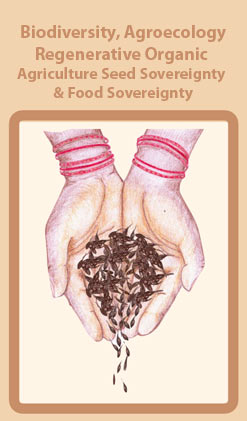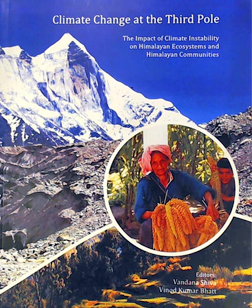Climate Change in the Himalaya
The Government fiddles while glaciers melt, springs dry and crops fail
Navdanya / Research Foundation for Science, Technology and Ecology have carried out an in depth participatory study with local communities in the Himalaya on the impact of climate change. These have been supplemented by studies by experts. These studies were presented at the National Conference on Climate Change in the Himalaya organised by Navdanya / Research Foundation for Science, Technology and Ecology / India International Centre at The Auditorium of India International Centre, Lodhi Road, New Delhi on November 17, 2009.
The Research Foundation was established in 1982 on the basis of the recognition that people facing the impact of ecological destruction are the best “experts” in knowing how their ecosystems work, how they are being destabilized and how their lives and livelihoods are being impacted.
The pollution of the atmosphere has led to climate change or more accurately climate instability and climate chaos. This has impact on agriculture, on water systems, on forest and biodiversity, on people’s livelihoods.
In Uttarakhand, the participatory research reveals that over the past decade, 34% of perennial streams have become seasonal, or have completely dried up. Water discharge has reduced by an average of 67%.
In 2007-2008, 50% - 60% of the crop failed due to drought. The 2009 drought has led to crop failure of 90%.
95% of the Chir Pine forests have had forest fires in 2009.
The drought has led to fodder scarcity which has led to a rapid decline in livestock. Livestock population has declined by 74% in Bhagirathi Valley, 72% in Mandakini Valley, 64% in Yamuna Valley and 57% in Alaknanda Valley.
In Ladakh, a high altitude desert, unprecedented rainfall has led to flash floods and washing away of villages (documented in the film “The Third Pole).
Communities in the Himalaya face a threat of survival due to climate instability and climate chaos.
But like Nero fiddled while Rome burnt, the Environment Ministry, the Ministry in charge of Climate Change Mitigation and Adaptation is fiddling with figures, while the Himalaya lose their springs and streams, their snows and glaciers.
The Ministry of Environment recently released a report “Himalayan Glaciers: A State of the Art Review of Glacial Studies, Glacial Retreat and Climate Change” by V.K. Raina.
The report reduces the complex phenomena of climate change to merely an increase of temperature, and uses this reductionism to create a false complacency about the Himalayan ecosystem.
All data presented by experts at the National Conference on Climate Change in the Himalaya organised by Navdanya / Research Foundation for Science, Technology and Ecology on 17th November, 2009 and also in the Ministry of Environment report acknowledges increase in deviation of seasonal snowfall, and retreat of glaciers. Yet repeatedly, the conclusion is drawn that there is no retreat. The inconsistency between data and conclusions is glaring.
For example, On Drung Drung glacier, the report states –
“During 2006-2008, snout of glacier caved in by 2.85m, along the central part. Along the west side, a retreat of 3m was noted. Over all the terminus of Drung Drung glacier, for the past three years has not revealed any significant retreat”
“The snout of the Siachen glacier of 2008 has retreated by 8 – 10 metres since 1995. Geomorphical evidences are indicative of poor response of the Siachen glacier to global warming”.
“For Gangotri, magnitude of displacement was calculated to be around 9.33cm per day, and the glacier calculated to be retreating at the rate of 4 cm per day or 14.6 m per year. The Gangotri glacier has been practically at a standstill.”
Two other unscientific arguments are used to say there is no impact of climate change on Himalayan glaciers and Himalayan Rivers.
The first is to state that the melting of Arctic glaciers is because they are at sea level, whereas the Himalayan glaciers are on average around 4000 m. “If we go by the topographic theory that maintains that because the temperature decreases with the altitude, mountain uplift causes glaciations, Himalayas should always retain glaciers in one form or the other.” On this argument the snows of Mt. Kilimanjaro would never have disappeared and there should never have been snow in the Arctic.
The final unscientific argument is that because the monsoon accounts for most of the flow of the Ganges, there is no need to worry. “Our data indicate the Ganges results primarily from monsoon rainfall, and until the monsson fails completely, there will be a Ganges river, very similar to present river”. While the monsoons account for most the river flow in the monsoons, the glacial melt accounts for flow in the lean season when it is most needed. With reducing glacial melt, the Ganges will become a seasonal river, not the perennial river that it is. And in any case, climate instability has also destabilized the monsoon as witnessed in the 2009 drought.
The Government’s complacency and carelessness on Climate Change in the Himalaya is anti-nature, anti-people, and anti-science. The Government is failing at the national level. This is costing peoples’ lives today, and will increase the human costs of Climate Change in the future if mitigation and adaptation measures are not addressed.
At the international level, if India aligns with the U.S to dismantle the United Nations Framework Convention on Climate Change (UNFCC) and the Kyoto Protocol, the world will lose the only legally being instrument on Climate Change. To be a “deal maker” for dismantling the climate treaty is to be a “deal breaker” from the perspective of the people and the planet.
The Indian Government should uphold the UNFCC at the international level and hold the rich countries to their obligations. At the domestic level it should avoid the fossil fuel path of dirty development which is also uprooting the majority of India from their lands and homes, first for the dirty and unjust development and then as climate refugees.


















